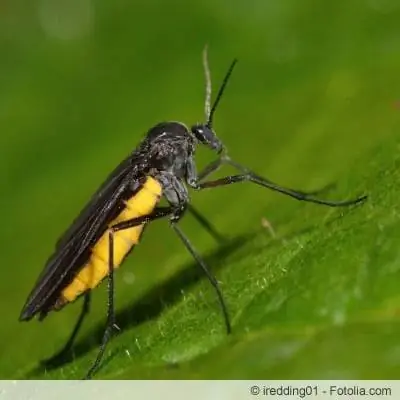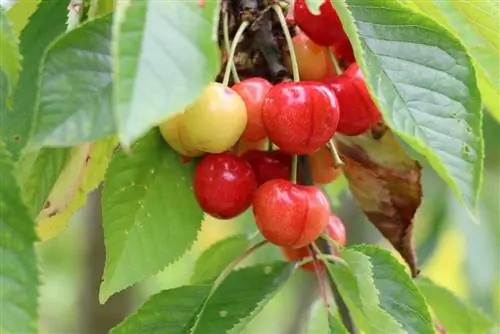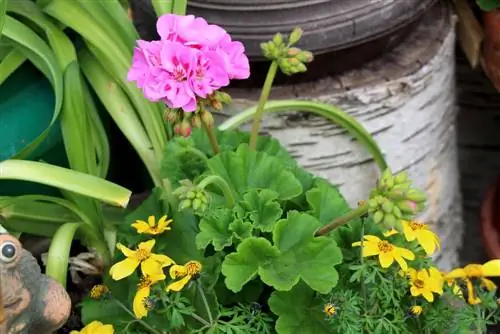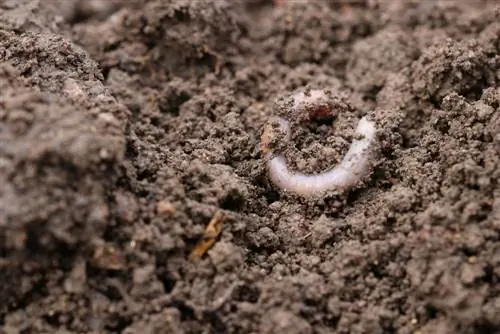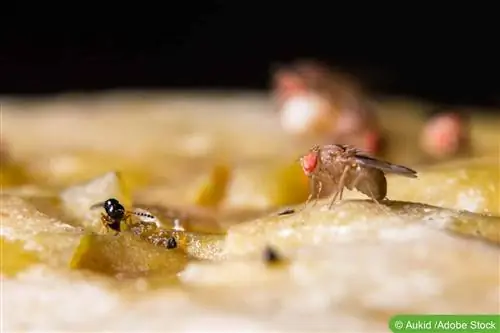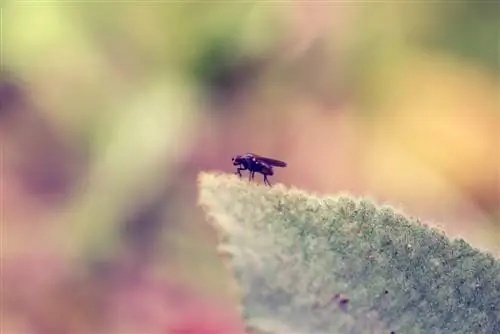- Author admin [email protected].
- Public 2023-12-17 03:39.
- Last modified 2025-01-24 12:45.
If there are small black flies in the potting soil, this sight puts the hobby gardener on high alert. As a rule, fungus gnats have made themselves comfortable in the substrate to lay their eggs. The larvae remove valuable nutrients from the soil and nibble on the roots, putting the plant at great risk. Only rarely is there an infestation by fruit flies. This type of insect looks very similar to fungus gnats, but it targets ripe fruit. Update your knowledge here about which remedies work against the plague.
Matches as an immediate measure
If you discover the first specimens of fungus gnats buzzing around above the potting soil, immediate countermeasures prevent the brood from spreading explosively. Without further ado, stick a few matches upside down into the substrate. The sulfur released kills the larvae immediately. In addition, the adult mosquitoes are prevented from laying further eggs. Replace the matches every 2 days as the small amount of sulfur is quickly used up.
Tip:
Yellow stickers provide more information about the level of infestation, as the adult fungus gnats stick to the glued boards. If a yellow sticky trap is littered with the 2-4 mm small, black dipterans, matches are no longer sufficient to combat it.
Insert quartz sand layer
The tiny flies and their larvae feel particularly at home in the moist environment of potting soil. Since letting the substrate dry out is out of the question, the following strategy solves the problem:
- Unpot the plant infected with fungus gnats
- Remove the infected substrate from the roots as much as possible
- Ideally, rinse the root ball with lukewarm water
- Plant up to two thirds of the pot height in fresh, disinfected substrate
- Paste a 0.5 to 1 cm thick layer of quartz sand
- Spread the remaining substrate over it
The quartz sand acts as a barrier for the voracious larvae. If you water the plant from below immediately, the upper substrate layer may remain very dry, so that it is no longer suitable as a breeding site for fungus gnats.
Nematodes
Nematodes have earned a good reputation in ecological pest control. These are tiny roundworms that are not visible to the naked eye. SF nematodes of the type Steinernema feltiae are crazy about the larvae of fungus gnats. The nematodes invade the brood to release a deadly bacteria. How to use the remedy:
- Add the nematodes delivered in clay mineral to water according to the instructions
- Water the infected potting soil with the mixture
- Observe the minimum temperature of 12 degrees Celsius
- Do not use under direct sunlight
The plant can then be watered according to the normal care protocol and fertilized organically or minerally. Only the administration of lime impairs the effectiveness of nematodes.
Predatory mites
If you are dealing with a hardened generation of fungus gnats, the nematodes will receive reinforcements in the form of predatory mites. Especially in the species Hypoaspis miles, the larvae are at the top of the prey list. The small predators initially go through a few stages of development, so they do not have as immediate an impact as nematodes. The mites make up for this disadvantage by actively hunting the pests over many weeks. This is how the application works:
- Predatory mites are delivered in an envelope with a peat-vermiculite mixture
- On the day of delivery, moisten kitchen paper and spread the predatory mites on it
- Sprinkle the granules with the mites onto the potting soil from the kitchen paper
- Do not incorporate the beneficial insects into the substrate
Leave the damp kitchen paper in the pot until the next day so that the remaining mites can migrate to the plant. Under optimal conditions of 18 to 25 degrees Celsius, they keep the soil slightly moist.
Mosquito-free
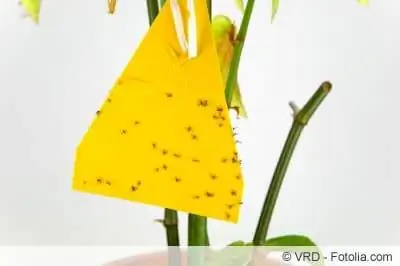
In the biological control of mosquitoes, a bacterium is used that does not spare the larvae of fungus gnats. The Bacillus thuringiensis israelensis concentrates solely on breeding and leaves the plant undisturbed. In addition, it is harmless to humans, pets or beneficial insects.
Proven home remedies
Environmentally and he alth-conscious hobby gardeners favor the use of traditional home remedies when pest infestations occur in the early stages. To effectively combat fungus gnats and fruit flies in potting soil, the following approaches can be considered:
- Enrich the watering water with 20 drops of tea tree or lavender oil per liter
- Sprinkle the potting soil with cinnamon or baking powder
- Put garlic cloves into the infected substrate
Harded gardeners cover the pot up to the root neck of the plant with a nylon stocking, which is closed as tightly as possible. In this way, the mosquitoes can no longer reach the potting soil and hatched larvae cannot escape. The escalating cycle of reproduction is thus interrupted. However, this measure takes 5-6 weeks, during which you will see the less than decorative appearance of an ornamental plant.
Chemical agents
Although fungus gnats pose no threat to human he alth, an infestation of potted plants in the room, winter garden, greenhouse and on the balcony causes great discomfort when clouds of pests rise from the potting soil at the slightest shock. If all natural control methods fail, insecticides offer the last resort. These preparations will get rid of the plague:
- Insect-free Neem from Compo
- Pest-free Lizetan AZ from Bayer
- Organic pest-free neem from Bayer
- Organic pest-free neem from Naturen
All preparations are based on azadirachtin, a chemical compound with the main ingredient from seeds of the neem tree. Please apply these insecticides strictly according to instructions, especially indoors.
Preventive measures
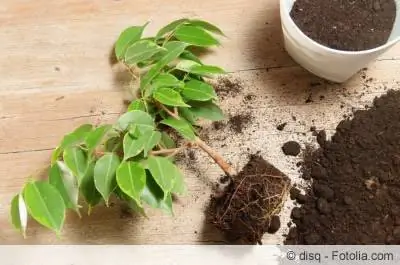
You can take the following precautions in advance to ensure that fungus gnats do not attack the potting soil of your plants:
Disinfect substrate
Regardless of the manufacturer's promises on the packaging, commercial potting soil may well already be riddled with eggs and larvae of fungus gnats and fruit flies. You can play it safe by converting the oven into a sterilizer. This is how it works:
- Pour the potting soil into a fireproof bowl
- Put the lid on loosely
- Heat in the oven at 150 degrees for 30 minutes
For smaller amounts of substrate, place in the microwave for 10 minutes at 800 watts. Also treat your own mixtures according to these instructions to ensure that there are no pests in them.
Tip:
Sowing and propagation of cuttings is explicitly threatened by insatiable larvae. Therefore, subject any growing soil to meticulous disinfection in the oven or microwave.
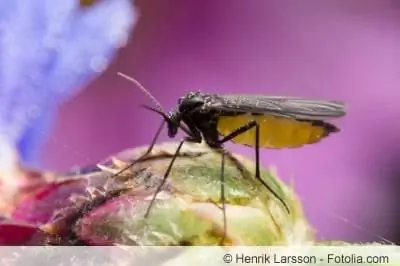
Mulching with sand
To prevent female insects from getting to the potting soil, cover the surface with a 1 centimeter thick layer of quartz sand. To avoid having to replace the sandy mulch after every watering, water the plant from below. To do this, place the pot in a bowl with a water level several centimeters high for a few minutes. Due to the capillary force, the water is drawn up into the root ball so that the surface can remain dry.
Prefer hydroponics
Almost all house and container plants are suitable for hydroponics. In this variant, the plant thrives in an inorganic substrate, such as expanded clay or Seramis and water. Since no soil is used, fungus gnats and fruit flies have no chance to settle here and lay their eggs. Since switching from potting soil to hydroponics is not always successful, hydroponics should be preferred when purchasing young plants.
Carnivores
The use of carnivorous plants has proven to be extremely effective in keeping fungus gnats and fruit flies away. If you place at least 1 carnivore per window sill, there is a good chance that the potting soil of the neighboring houseplants will remain free of pest infestation.
Conclusion
The next time a swarm of tiny insects rises from the potting soil, you are now prepared to put a stop to the nefarious activity. The remedies presented here against fungus gnats and their larvae have proven to be excellent for freeing a beleaguered plant from them in good time before it suffers significant damage. If you follow the recommended prevention methods, you won't even have to worry about combating them. As a rule, these are not fruit flies. Although these insects look very similar to fungus gnats, they derive no benefit from plant soil.

